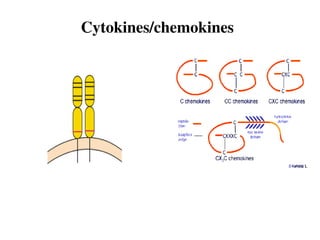
4.3. Cytokines.pdf
- 2. Cytokines • “Cytokines” are soluble protein secreted by the cells of innate and adaptive immunity and mediate many of the functions of these cells • Are molecules that communicate among widely dispersed cells and organs of the immune system
- 3. Chemical structure of cytokines • Low molecular weight proteins, < 30kD • High affinity for receptors • Active in picomole amounts –Because their affinities are so high, cytokines can mediate biological effects at picomolar concentrations.
- 4. Names of Cytokines • Source – Lymphokines – secreted by lymphocytes – Monokines – secreted by monocytes • Function – Chemokines – cytokines that affect chemotaxis and other aspects of leukocyte behavior – Interferons – Involved in antiviral response – Intercellular action – Interleukins – secreted by some leukocytes and act upon other leukocytes Chemokines-regulate mainly Immune cell migration. But, Cytokines have broader function in cell growth, differentiation, & immune regulation!
- 5. Action of Cytokines • Autocrine – Affects the generating cell (self) • Paracrine – Affects cells in the immediate vicinity • Endocrine – Affects cells remote from the secreting cell
- 7. T lymphocytes often secret cytokines at the site of contact with APCs. Most cytokines act close to where they are produced
- 8. Cytokines have 5 attributes 1. Pleiotropy: when a given cytokine has different effects on different cells. 2. Redundancy: when two or more cytokines mediate the same function. 3. Synergism: when the combined effect of two or more cytokines is greater than the effect of the individual cytokines. 4. Antagonism: when the effects of one cytokine inhibits the effects of another cytokine. 5. Cascade induction: the action of one cytokine on a target cell induces that cell to produce one or more other cytokines that in turn induce other target cells.
- 10. Cytokines have numerous biological functions • The generation of cellular and humoral immune responses, – IFN-γ, IL-4, 5, 12, TNF-α • The induction of the inflammatory response, – IL-1,6, TNF-α • Control of cellular proliferation and differentiation – IL-10,13 • The regulation of hematopoiesis, – GM-CSF, G-CSF • Wound healing – TGF-β
- 11. Cytokines Mediate the Activation, Proliferation, and Differentiation of Target Cells
- 12. *Mononuclear phagocytes are the principal source of cytokines of innate immunity Tumor necrosis factor (TNF) IL-1 IL-6 Type I IFNs IL-12 IL-15 IL-18 chemokines Proinflammatory cytokines Cytokines that mediate and regulate innate immunity
- 13. Roles of cytokines in innate immunity and inflammation 0 1 3 6 Hours after LPS injection
- 14. Cytokines mediate and regulate adaptive immunity at different phases
- 15. Network of cytokine actions produced by leukocytes
- 16. Cytokine of adaptive immunity are produced mainly by T lymphocytes in response to specific recognition of protein Ags. The function of T helper cells is mediated by cytokines
- 17. Cytokines Belong to 6 Structural Families: • Different amino acid sequences, similar structures Interleukin I family (proinflammatory cytokines) Hematopoietin family (Class I cytokines) Interferon family (Class II cytokines) Interleukin 17 family (inflammatory cytokines) Tumor necrosis factor (TNF) family Chemokine family
- 19. Cytokine receptors There are five families of cytokine receptors: 1. IL-1 family (Immunoglobulin superfamily) receptors 2. Class I cytokine receptor family (or Hematopoietin receptor family). 3. Class II cytokine receptor family (or interferon receptor family). 4. TNF receptor family 5. Chemokine receptor family (JAK-STAT) (IRAK) G- protien
- 22. Chemokines • A subfamily of cytokines primarily functions in directing migration of cells, these are called “chemotactic cytokines” or “chemokines” • Chemoattractant Cytokines • Small (8-10kd) • Promote recruitment and activation of leukocytes
- 23. Chemokine Subclasses • Most chemokines have 4 cysteine residues which form disulphide bonds –C class – Only has 2 cysteines not 4 (example: Lymphotactin) –CC class – The first two cysteines are adjacent (example: MCP-1/CCL1, RANTES/CCL5) –CXC class- The first two cysteines are not adjacent (example: IL-8) –CX3C class – Has 3 amino acids between the first two cysteines and a different N-terminal Monocyte chemoattr Protien-1 Fractalkine. Attract eosinophils, basophils & T-cells.
- 26. Chemokine Function • Chemokines promote chemotaxis in the direction of highest concentration
- 28. Chemokine Receptors • Specific receptors bind specific chemokine • There are also shared receptors • Promiscuous receptors bind any class • Viral encoded receptors
- 31. • Chemokine receptors are differentially expressed on effector T-cells
- 32. CC-receptors and HIV infection